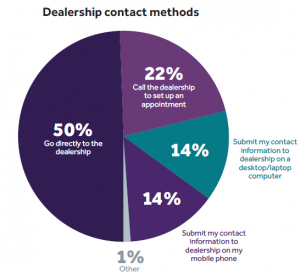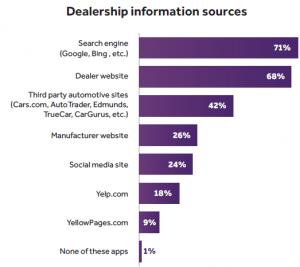Today, all leads are Internet leads – especially on-the-lot shoppers – but I’d bet you don’t source on-the-lot shoppers as such. Dealerships that treat all leads – traditional, digital, and on-the-lot – as Internet leads are going to be the most successful. So, how are car shoppers learning about your dealership?
How Consumers Find Dealership Information
Half of shoppers go directly to dealerships, rather than contacting them ahead of time (Figure 1)¹. That’s a big insight! These same car shoppers are most likely using their smartphones for maps and directions, making these metrics even more valuable when evaluating digital ad spend. This also makes proper attribution of car shoppers on a dealership’s lot even more important.

Figure 1. Mobile Influence on Car Shopping. February 2017.
One-quarter submit contact information and another quarter call for an appointment (Figure 1). While we know that half of car shoppers do not send a traditional lead like phone or email, one-quarter still do send traditional leads making these important lead types to monitor (Figure 1).
However, our data on dealership information sources points out the need for understanding the car shopper lead path journey. While search engines are a primary search path for car shoppers from our study (Figure 2) where car shoppers were allowed to pick multiple information sources, that does not indicate where consumers started their journey. Indeed, by the time a consumer chooses to type in a make or model or a dealership name, they’ve researched enough to actively seek out that information from that specific dealer – but how did they first hear about you? Even the dealership’s website seen in Figure 2 seems prominent, car shoppers most likely found the dealership from another third-party source before visiting. Last-click attribution is not representative of how car shoppers initially found a dealership.

Figure 2. Mobile Influence on Car Shopping. February 2017.
What Can You Do to Evaluate Walk-In Customers?
You need to adopt multi-touch metrics. The car shopper journey from awareness to an on-the-lot purchase is complicated. On-the-lot shoppers are influenced by several touch points, ranging from organic searches to reviews and third-party sites such as Cars.com. Armed with a wealth of research, they’re visiting dealers’ lots confident that they don’t need to engage with a dealer ahead of time. Consequently, dealers need to use multi-touch attribution strategies, not just last touch attribution or traditional lead metrics, to understand the value of their digital marketing spend in today’s modern car buying journey.
Action Steps
- Ensure you have an attribution process in place to know how consumers found your dealership and work with your third-party vendors to evaluate that performance.
- Create a holistic approach to understanding how consumers are researching you and all available touchpoints with your dealership and brand.
- Evaluate your SEO & SEM performance to ensure you’re not wasting money and are driving the right time of leads and or traffic you need.
- Review your SEO & SEM spend and place your advertising dollars with more relevant touch points where consumers start their journey to lead them to your lot.
Once you face the reality that your existing lead data is incomplete either because lead data isn’t being sent before an on-the-lot visit, doesn’t account for multi-touch attribution, or that your sales team is inputting incomplete information into your CRM, you can properly analyze your advertising approach to drive consumers to you. Traditional leads as the industry knows them will soon be a thing of the past. It’s time for you to dig into your available data in more depth, work with your vendor partners, and do your homework. After that, you can better optimize your marketing spend to be in front of consumers at all touch points.
[1] Mobile Influence on Car Shopping. Cars.com, February 2017.



